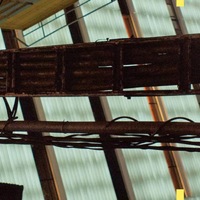
Fenn O'Berg
In Stereo
(Editions Mego; 2010)
By Joel Elliott | 8 May 2010
Is it progressive for an improvisational group to shift into the studio? I’ve always wondered. Following a recent fiasco with a band who will remain nameless, in which said band accused me of questioning the veracity of their improvisational integrity when really I was questioning the need to flaunt this status like it was some kind of magic trick (and making a stupid joke in the process), it may seem strange to highlight the distinction now. Allow me to clarify: I don’t think the choice between improvising and recording parts separately and in the studio is an arbitrary one, nor do I think one approach is inherently better. I do think there is an implicit, if unintended, message in declaring that a record was done in a single take without overdubs—as opposed to just saying “this album was recorded live in such-and-such a location”—which relates to the privileging of instrumental skill and virtuosity (though little of that remains in cases of prepared instruments or laptop improvisation, since the “skill” lies largely in the preparation and the exercise of restraint) and all the old connotations of authenticity and spontaneity associated with jazz and a zillion other genres of music. There’s nothing wrong with explaining how an album was made, but you never see artists like Fennesz, in his more studio-based work like Endless Summer (2001) and Venice (2004), explain in the liner notes: “This album was recorded in 2573 takes using 107 different tracks.”
Improvisation matters because it tends to be the most direct way to make music that’s unpredictable, that rides the tension between order and chaos, and that makes the real-time encounter between musicians tangible (or, in the case of solo improv, the vulnerability of playing unaccompanied). Critics often highlight the ways in which electro-acoustic heavyweights like Supersilent sound as if their music was composed ahead of time, but really that band wouldn’t be what it is were it not for the feeling of disjuncture alongside an almost mystical serendipity.
With In Stereo the trio of Christian Fennesz, Jim O’Rourke, and Peter Rehberg, whose first two albums were part of the pioneering wave of laptop improvisation in the late ’90s, turn to the studio. The distinction might be somewhat trivial, at least on the surface—the press release states that the album was recorded over the course of a week in Tokyo, and thus probably consists of a good deal of real-time improvisation—but the differences are immediately evident. Whereas past recordings were full of odd samples and turbulent shifts, In Stereo is almost all abstract digital and analog glitch, riding comfortably in layers of sound. It could have easily been made by one person—much of it recalls Keith Fullerton Whitman’s live performances, albeit relatively denser given the amount of material. The band is finally speaking with one voice, but is it for the best?
There is obviously some intention to simplify and condense here. The title of the album is coy, as if stereo sound was the only technology that mattered, or as if listeners never had the opportunity to use both their ears before now. There is definitely a remarkable use of space and localized sound: on “Part V,” the sounds seem to come from so many different angles and with such constantly varying modifiers that it becomes impossible to actually describe in any detail what’s going on. The only concrete response I can take away is that the track still radiates a calm that constitutes a far cry from the schizophrenic energy of their past releases, and probably represents the one genuine progression on this album.
But the more minimal tracks are far less effective. “Part I,” with its sudden intrusion of furious percussion and hammering piano, even sounds off: the instruments enter too suddenly (but not suddenly enough to be really disruptive) and leave without ever going anywhere. The Return of Fenn O’Berg (2002) had moments that didn’t quite gel either, but it had a playful, subversive quality. In Stereo takes less risks, and so when it misses, it feels less earned. Of course I understand the need, eight years after their last album, to start fresh, especially considering the way electronic music has developed in that time. Strangely enough though, if The Return of.. was released in 2010 instead of 2002, it would still sound more ahead of its time than this record. It may have been influential, but few artists seem to have taken up the will to completely dispose of the notion of a coherent or unified sound. Then again, if their previous records didn’t exist, In Stereo might sound like a much needed adrenaline-boost to boring drone music. A lot of its proponents would do well to take note of that deep thud of percussion on “Part VI” that seems to be felt more than heard.
But if In Stereo, like their previous records, is ultimately culled from collective improvisations, can we really speak of a different approach? Perhaps the difference is psychological: the “studio” as a concept, with all the connotations of refinement and precision that it brings, represents a distinct shift from the willful ephemerality and desire for an immediate, visceral response that often accompanies live improv. When the trio first began playing live shows a dozen or so years ago, they used to position themselves at opposite corners of a club, communicating over a crowd. Maybe they just need to get unfamiliar with each other again?





